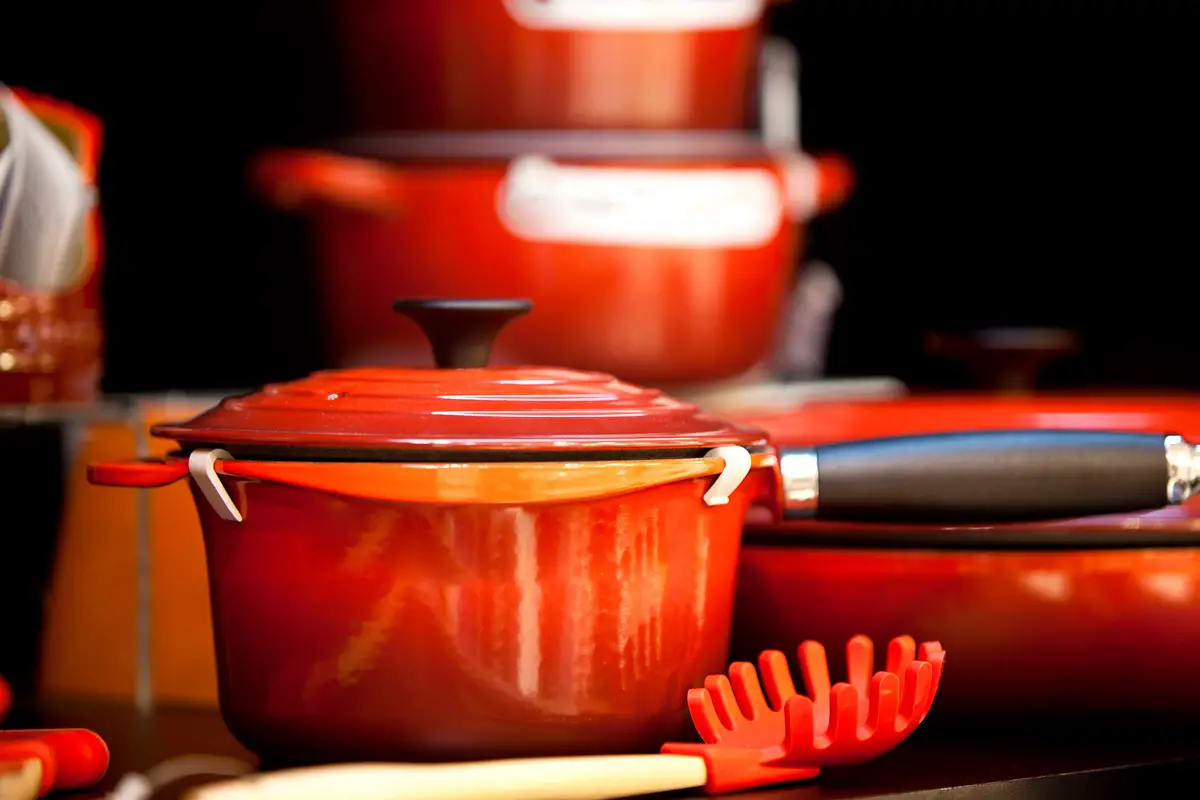Companies worldwide manufacture products in China because of the overabundance of low-wage workers and more affordable raw materials available there, which reduces the cost of making the product.
All this overseas business from other countries makes China responsible for approximately one-fifth of all globally manufactured goods.
Goods produced in China have long been a point of contention for governments worldwide on whether the practice is a positive one for their countries’ economies.
In addition, consumers often wonder how well these products produced in China stand up to those made in other countries, like France and the US.
In this blog post, we’ll probe into Le Creuset products and whether the company produces its various lines of kitchenware in China, either whole or in part.
First, A Little About Le Creuset: The Brand’s Beginning.
Le Creuset, which translates to “the cauldron” or “the crucible.”
However, the definition is the same for both: a ceramic or metal container that substances get placed in to subject them to a melting process or extremely high temperatures.
The Le Creuset company’s first home was a commune in northern France’s Hauts-de-France region called Fresnoy-le-Grand, part and parcel of the Aisne department.
The two gentlemen responsible were Octave Aubecq (a Belgian enameling specialist) and Armand Desaegher (a Belgian casting specialist), who, in 1925, opened a foundry there.
Later that year, the first cocotte, also known as a French oven, made its way out of the kiln.
This event laid the foundation for the extensive range of cookware and kitchen utensils created by the Le Creuset company we see today.
Le Creuset’s Cost Point: Why Is It Expensive?

User Reviews:
According to the Google search: Le Creuset Dutch Ovens, a Le Creuset Dutch Oven costs anywhere from $160 to $370.
The price variances mentioned here differ due to size contrasts from 1.5 quart to 5.5 quart.
Even though Le Creuset has a tremendous line of kitchenware, we want to note that we’ll use the Le Creuset Dutch Ovens as an example for this post.
Here are a few reasons why the Le Creuset Brand is expensive:
- Labor– Made in France typically means using higher-cost labor.
- Marketing– Le Creuset has a more robust marketing plan which adds cost.
- Quality Control– Le Creuset maintains higher quality control and sourcing standards.
- Materials– Le Creuset products contain higher enamel quality than that of many rivals and counterfeiters.
- Miscellanious Overhead– Items like the European value-added tax, other taxes, tariffs, and energy to name a few are higher.
Where Exactly Is Le Creuset Made?
To say emphatically, France is where Le Creuset products get produced isn’t that simple. Nor is the question, “Is Le Creuset made in China?” any more straightforward.
Not all of Le Creuset’s products come from France, but the brand manufactures all cast iron products at the original factory in Northern France.
In addition, Le Creuset produces its stainless steel product line in Portugal, the stoneware is Thailand manufactured, and their kitchen accessories get made in China.
We’d like to quickly note just because some of their products don’t get manufactured in France doesn’t mean they’re sub-quality.
On the contrary, the Le Creuset name has always stood for quality. Their authentic products undergo stringent inspection at various levels in the manufacturing process before released for sale.
How To Spot A Fake Le Creuset Product
In a perfect world, if it’s marked Le Creuset, it’s produced in France, and the quality is unsurpassed. However, the buyer beware; this is not the case.
Knowing not all authentic Le Creuset products get made in France, as mentioned in the previous passage, how do you spot a fake when not made in China?
Hopefully, these key pointers help you avoid the catastrophe of ending up with a fake Le Creuset product:
No Warranty
This pointer is probably the most obvious. What fraudulent company supplies their information for any purpose?
However, as with the cost pointer, don’t assume a printed warranty on or inside the box means the product is authentic. In the day and age of the smartphone, we’re able to check out information on the go at warp speed.
We can’t stress enough the importance of looking up information before you buy.
If the warranty jargon doesn’t make sense or any contact information given doesn’t check out with the official Le Creuset website or list of authorized sellers, don’t buy it.
Off Colors
Brands like Le Creuset pride themselves on the authentic coloring of their products.
High-end companies hire a department of people to design attributes like shape, texture, and colors.
Characteristics that make a product unique, easily recognizable, and endearing to consumers. With fakes, the color itself, however close, will look as little as a shade off.
As a result, it won’t have the classic genuine vivid color of an authentic Le Creuset Dutch Oven.
Too-Good-To-Be-True Pricing
If the price sounds too good to be true, it probably is. Don’t assume, however; fakes have a cheaper price tag.
In some cases, artful imitations produced by educated scammers cost the same price as the authentic Le Creuset products, often bilking consumers out of hundreds.
For example, we’ve seen close and not-so-close fake Le Creuset Dutch Ovens as low as $39 and as high as $199.
Resources
- Michelle for OvenSpot. (Updated: 2021, 22 May). How Can You Tell a Fake Le Creuset?
- CenturyLife.Org. (n.d.) How to choose an enameled Dutch oven: Is Le Creuset worth it? Le Creuset vs Staub: is Staub worth it? Why does Le Creuset cost so much? What are my alternatives?
- Wikipedia. (2018, 4 October) Le Creuset



